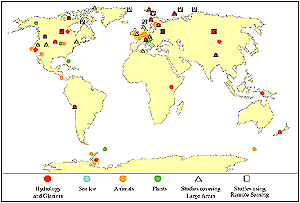2. Emergent Findings
2.1. Recent Regional Climate Changes, particularly Temperature Increases,
have Already Affected Many Physical and Biological Systems

Figure SPM-1: Locations at which systematic long-term studies meet
stringent criteria documenting recent temperature-related regional climate
change impacts on physical and biological systems. Hydrology, glacial retreat,
and sea-ice data represent decadal to century trends. Terrestrial and marine
ecosystem data represent trends of at least 2 decades. Remote-sensing studies
cover large areas. Data are for single or multiple impacts that are consistent
with known mechanisms of physical/biological system responses to observed
regional temperature-related changes. For reported impacts spanning large
areas, a representative location on the map was selected. |
Available observational evidence indicates that regional
changes in climate, particularly increases in temperature, have already affected
a diverse set of physical and biological systems in many parts of the world.
Examples of observed changes include shrinkage of glaciers, thawing of permafrost,
later freezing and earlier break-up of ice on rivers and lakes, lengthening
of mid- to high-latitude growing seasons, poleward and altitudinal shifts of
plant and animal ranges, declines of some plant and animal populations, and
earlier flowering of trees, emergence of insects, and egg-laying in birds (see
Figure SPM-1). Associations between changes in regional
temperatures and observed changes in physical and biological systems have been
documented in many aquatic, terrestrial, and marine environments. [2.1,
4.3, 4.4, 5.7,
and 7.1]
The studies mentioned above and illustrated in Figure SPM-1
were drawn from a literature survey, which identified long-term studies, typically
20 years or more, of changes in biological and physical systems that could be
correlated with regional changes in temperature. 5
In most cases where changes in biological and physical systems were detected,
the direction of change was that expected on the basis of known mechanisms.
The probability that the observed changes in the expected direction (with no
reference to magnitude) could occur by chance alone is negligible. In many parts
of the world, precipitation-related impacts may be important. At present, there
is a lack of systematic concurrent climatic and biophysical data of sufficient
length (2 or more decades) that are considered necessary for assessment of precipitation
impacts.
Factors such as land-use change and pollution also act on these physical and
biological systems, making it difficult to attribute changes to particular causes
in some specific cases. However, taken together, the observed changes in these
systems are consistent in direction and coherent across diverse localities and/or
regions (see Figure SPM-1) with the expected effects
of regional changes in temperature. Thus, from the collective evidence, there
is high confidence6
that recent regional changes in temperature have had discernible impacts on
many physical and biological systems.
2.2. There are Preliminary Indications that Some Human Systems
have been Affected by Recent Increases in Floods and Droughts
There is emerging evidence that some social and economic systems have been
affected by the recent increasing frequency of floods and droughts in some areas.
However, such systems are also affected by changes in socioeconomic factors
such as demographic shifts and land-use changes. The relative impact of climatic
and socioeconomic factors are generally difficult to quantify. [4.6
and 7.1]
|